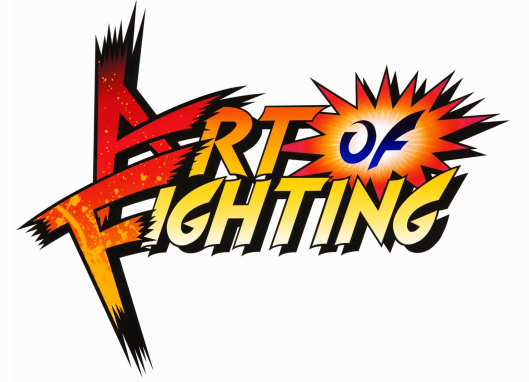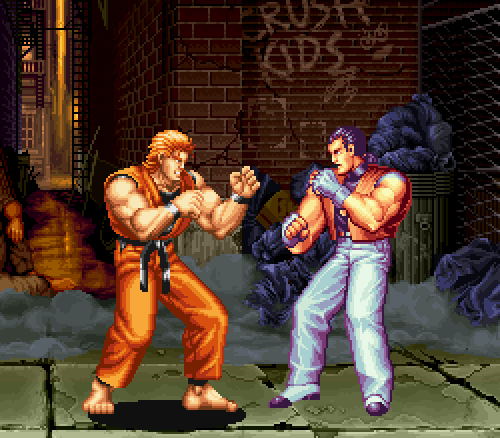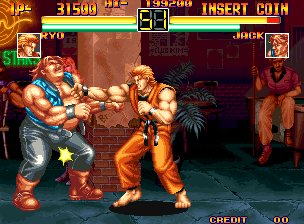Art
of Fighting

STORY:
The storyline of Art of Fighting takes
place in 1978. Ryo Sakazaki and Robert Garcia set out to find Ryo's sister, Yuri, who was
kidnapped by Mr. Big. Mr. Big took Yuri to entice Takuma Sakazaki, Ryo's father
and originator of Kyokugen Karate, and also because Ryo refused to work for Big.
After Ryo & Robert defeat Mr. Big, they face the enigmatic Mr. Karate. Art
of Fighting's story ends with a cliff-hanger; Yuri is about to disclose the true
identity of Mr. Karate as their father Takuma.
REVIEW: Continuing
the early 90's fighting game craze, Art
of Fighting is well known to be SNK's answer to Capcom's smash
hit, Street Fighter 2: The World Warrior. A little over a year after SF2 redefined
the demographic of arcades, Art of
Fighting hit the scene in late 1992, offering a similar gameplay style to SF2 and
a
unique cast of fighters of its own. AOF also introduced an
eye-catching "graphical scaling" effect, which makes characters and backgrounds smaller as fighters
move apart (later to become a visual trademark of SNK fighting games). AOF was one of
the first fighting games to put SNK on the map, and was the starting place for
several characters whom would later become "icons" in the
fighting game realm.
While not nearly as popular as the headlining Street Fighter 2 series, AOF
actually brought some unique ingredients to the fighting game recipe. Even though SNK
was, in some ways, "riding the coattails" of Capcom's success, they were at least
trying something different - having an actual story unfold through the 1-player
experience of Art of Fighting. Only the 2 main protagonists (Ryo and Robert)
are selectable in the Arcade / Story Mode, thus allowing the story of Yuri's
kidnapping and rescue to unfold. Interestingly enough, once a second player
joins in, both players can then select from any of the 10 characters during
Versus battles.
|

|
|
Meet
Ryo and Robert... the two charismatic heroes of AOF!
|
For the most part, AOF follows the traditional gameplay format put in
place by earlier fighting games. However, AOF differs by limiting
special moves with the Spirit Gauge. Located under a character's
life meter, the Spirit Gauge limits the use and power of special attacks. When
a character performs special moves, their spirit gauge is depleted and their
special attacks become weaker. Taunting (to lower the opponent's Spirit Gauge)
and off-the-wall attacks gave arcade fighting game players a unique experience.
In retrospect, AOF isn't nearly as playable as its competition... and
is a good example of why fighting games need combos and (mostly) free access
to special moves. 
During cut-scenes, instructions are given on how to perform a powerful super move (dubbed the "Super
Death Blow"), which requires an advanced button command (advanced at the
time, that is). Desperation Attacks can be performed when the player's health is
low and the life bar is flashing red.
The character sprites of AOF are colorful,
and notably larger than those from Street Fighter 2. Although they're definitely "beefier" than
their SF2 counterparts, the characters also come off as a bit more
"stiff" visually and gameplay-wise. This slight feeling of stiffness
was definitely noticeable when used to the "silky smooth" gameplay
of Street Fighter 2. Some AOF designs themselves were also lacking in the originality
department... (yes, I'm looking at you John). Obviously, several characters
and special moves "blatantly" take inspiration from Capcom's SF2
universe. In retrospect, AOF's roster was charming and unique enough to
carve out its place in 90's arcades.
|

|
|
Drunk Biker = punching bag
for real martial artist.
|
The visuals of Art of Fighting were
unmistakably impressive in 1992 (and many years after). Character faces actually become bruised as the fight progresses, and
backgrounds are large, colorful, and moody. One of the most notable aspects of
the visuals is the background scrolling
effect, which was very impressive at the time. This effect also gives players a wider view of the battleground,
an "original" visual element for a fighting game at the time. Hit effects and
projectiles also made a statement in AOF,
even though a few were clearly rip-offs of SF2's effects.
One area where Art of Fighting "one-upped" Street Fighter
2, are the bonus games. During a player's run though of the story mode,
they are eventually given the option to select between 3 different bonus challenges,
which include: Bottle Smash, Ice Smash, &
Initiate Super Death Blow. All of these bonus games were exciting, fun, and
definitely helped AOF
stand apart from other fighting games.
|

|
|
AOF's
bonus games were innovative and eye-catching!
|
Overall,
Art of Fighting was an
attractive arcade game, especially when compared to other arcade games out in 1992. AOF had a decent story for a video game, interesting characters, catchy music, cool super
moves, and innovative "extras" that other fighting games lacked. The original arcade version
of AOF was great, but unfortunately, the home ports
really didn't live up to the original in terms of graphics. The SNES and Genesis versions
featured much smaller, less detailed 2D sprites, and the characters & stages were
missing graphical details & animations. The cool scrolling effect also didn't translate very well
in the home ports. Needless to say, make sure you're playing the arcade version
to get the full Art of Fighting experience!
|
|

| Page Updated: |
October
10th, 2025
|
| Developer(s): |
SNK |
| Publisher(s): |
SNK |
| Artwork
By: |
Shinkiro Poster & Prologue Comic
Eiji Shiroi Character Artwork |
| Platform(s): |
NeoGeo, NeoGeo CD, Super Nintendo, Sega Genesis, PC, Wii
Virtual Console, PS2, PSN, PS4, Switch |
| Release Date(s): |
Sep. 24th, 1992
 / /
 Arcade Arcade
May
11th, 2006
 PS2 - in Art of Fighting: Anthology PS2 - in Art of Fighting: Anthology
May
15th, 2007
 PS2 - in Art of Fighting: Anthology PS2 - in Art of Fighting: Anthology
Oct. 8th, 2007 Wii Virtual Console
Dec. 21st, 2010
PlayStation Network
Sep.
4th, 2017  PS4 - in Art of Fighting: Anthology
PS4 - in Art of Fighting: Anthology
Sep.
21st, 2017
Nintendo Switch
|
| Characters: |
Ryo Sakazaki,
Robert Garcia, Todoh,
Jack Turner,
Lee Pai Long,
King,
Mickey Rogers,
John Crawley,
Mr.
Big, Mr. Karate
|
|
|
|
Featured Video:
|
|
|
| Related Games: |
Art
of Fighting 2, Art of Fighting 3, Fatal
Fury, Fatal Fury 2, Fatal Fury Special, Samurai
Shodown,
Samurai Shodown 2, The King of Fighters '94, Street
Fighter 2,
Street Fighter 2: Champion Edition,
Buriki One, Neo Geo Battle Coliseum |
|

|
|
Gameplay
Engine
|
7.5 / 10
|
|
Story
/ Theme
|
9.0 / 10
|
|
Overall
Graphics
|
8.5 / 10
|
|
Animation
|
7.0 / 10
|
|
Music
/ Sound Effects
|
7.5 / 10
|
|
Innovation
|
7.0 / 10
|
|
Art Direction
|
8.0 / 10
|
|
Intro / Presentation
|
9.0 / 10
|
|
Replayability / Fun
|
6.0 / 10
|
|
"Ouch" Factor
|
6.5 / 10
|
|
Characters
|
7.0 / 10
|
|
BOTTOM LINE
|
7.8
/
10
|
|
Review based on Arcade version
|
|
| Final
Words: |
Like
many arcade kids born into the late 80's / early 90's era of gaming, I was an avid Street Fighter 2 player in 1992. When I first tried out SNK's Art
of Fighting, the game certainly didn't feel "as smooth" as SF2 to play... but there was still plenty of things to like about SNK's brand of 2D fighting game. (For one, AOF was a great 'alternative' if there was too big of a crowd in front of the SF2 cabinet. No, seriously... that was a legit issue back then at
popular arcades.)  Put your quarter up! Put your quarter up!
Art of Fighting put a strong emphasis on the storyline, which jumps out at you as soon as you start Arcade mode. This was not only innovative to fighting games but executed exceptionally well. Many 80's and 90's martial arts films really fit into the "vibe" of AOF. (Robert Garcia resembling a mix of Jean Claude Van Damme and Steven
Seagal, for one.)
There was an AOF machine at one of my family's main vacation spots back
in the day (inside the very hotel we always stayed at). It was one of the few fighting games at the hotel, so I actually became pretty decent at AOF - quickly learning all the exploits versus the CPU so I didn't lose my quarters!  My SF2 background definitely helped with
that... and gave me the edge against human challengers (so I could keep playing on my machine). My SF2 background definitely helped with
that... and gave me the edge against human challengers (so I could keep playing on my machine).  I remember loving the fact that after defeating a human opponent or two, I could
just return to my spot in story mode. (And often, the player I defeated would happily watch me go through story mode instead of challenge me again - just to see me lose to the stupidly-tough boss, Mr. Big I remember loving the fact that after defeating a human opponent or two, I could
just return to my spot in story mode. (And often, the player I defeated would happily watch me go through story mode instead of challenge me again - just to see me lose to the stupidly-tough boss, Mr. Big  ). Good times. I think I beat him a couple times, but I'd rather restart the game
than waste quarters on that cheap bastard. ). Good times. I think I beat him a couple times, but I'd rather restart the game
than waste quarters on that cheap bastard.
Of course, AOF has a few "copycat" character designs resembling certain SF2 icons... but most are original at the end of the day. Furthermore, SNK's beautiful and beefy 2D character sprites were MASSIVE onscreen and no doubt impressive for years to come. I loved AOF for
its unique spin on the 2D fighting game recipe. AOF
was followed by two decent sequels. Many of AOF's original
characters also live on in crossover titles like The King of Fighters and Capcom VS SNK.
~TFG
Webmaster | @Fighters_Gen
|
|
|
|
|
|
|
|
|
|
|
|
|
|
|